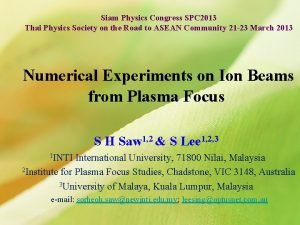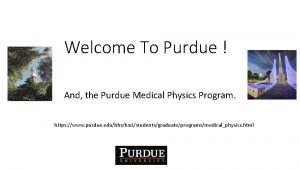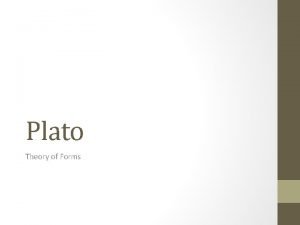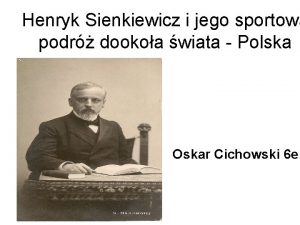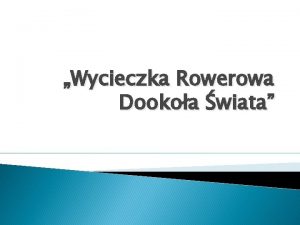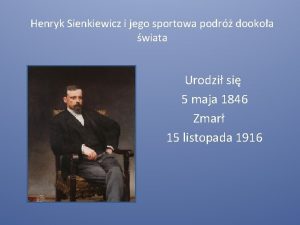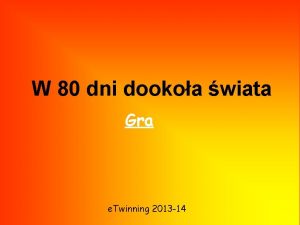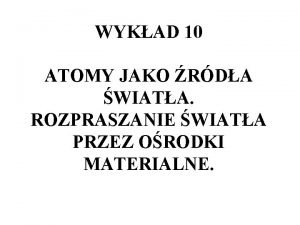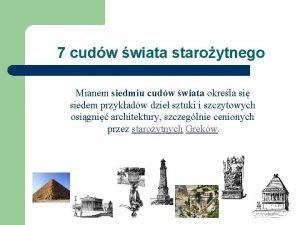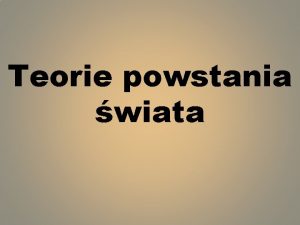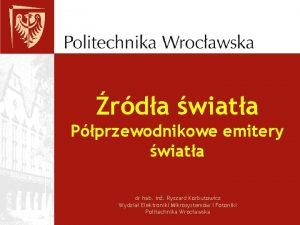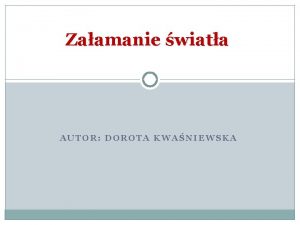Dookoa wiata z World Congress on Medical Physics



















- Slides: 19

Dookoła świata z World Congress on Medical Physics and Biomedical Engineering Wojciech Bulski

Past World Congresses * In association with the International Organization for Medical Physics. ** World Congress on Medical Physics and Biomedical Engineering. I 1958 Paris France II 1959 Paris France III 1960 London United Kingdom IV 1961 New York U. S. A. V 1963 Liege Belgium VI 1965 Tokyo Japan VII 1967 Stockholm Sweden VIII 1969 Chicago U. S. A. IX 1971 Melbourne Australia X 1973 Dresden DDR XI* 1976 Ottawa Canada XII* 1979 Jerusalem Israel XIII* 1982 Hamburg Germany XIV* 1985 Helsinki Finland XV** 1988 San Antonio U. S. A. XVI** 1991 Kyoto Japan XVII** 1994 Rio de Janeiro Brazil XVIII** 1997 Nice France XIX** 2000 Chicago U. S. A. XX** 2003 Sydney Australia XXI** 2006 Seoul Korea XXII 2009 Munich Germany XXIII 2012 Beijing China XXIV 2015 Toronto Canada

International Federation of Medical and Biological Engineering - IFMBE Prezes: Ratko Magjarevic Założyciel: Vladimir Zworykin Założenie: 1959 International Organization for Medical Physics - IOMP Prezes: Slavik Tabakov Siedziba główna: York, Wielka Brytania Założenie: 1963 International Union for Physical and Engineering Sciences in Medicine - IUPESM Prezes: James C. H. Goh, Ph. D Założenie: 1980 Siedziba główna: Ottawa, Kanada Organizacja macierzysta: Międzynarodowa Rada Nauki

International Federation of Medical and Biological Engineering - IFMBE Prezes: Ratko Magjarevic Założyciel: Vladimir Zworykin Założenie: 1959 In 1959 a group of medical engineers, physicists and physicians met at the 2 nd International Conference of Medical and Biological Engineering, in the UNESCO Building, Paris, France to create an organization entitled International Federation for Medical Electronics and Biological Engineering. At that time there were few national biomedical engineering societies and workers in the discipline joined as Associates of the Federation. Later, as national societies were formed, these societies became affiliates of the Federation.

In the mid-sixties, the name was shortened to International Federation for Medical and Biological Engineering. Its international conferences were held first on a yearly basis, then on a two-year basis and eventually on a three-year basis, to conform to the practice of most other international scientific bodies. As the Federation grew, its constituency and objectives changed. During the first ten years of its existence, clinical engineering became a viable subdiscipline with an increasing number of members employed in the health care area. The IFMBE mandate was expanded to represent those engaged in Research and Development and in Clinical Engineering. The latter category now represents close to half of the total membership. The Federation now has an estimated 120, 000 members in 59 affiliated organizations. The category Honorary Life Member is given to individuals who have served the Federation in various ways as affiliate members.

Observer status may be temporarily granted to a society or organization (pending the determination of their definitive application) to attend the General Assembly. The Federation actively looks at ways to assist national or regional groups encountering some difficulties in qualifying for affiliation. The IFMBE has also achieved a close association with the International Organization of Medical Physics. Its international conferences, commencing with the 11 th in 1976 have been aligned or combined with those of the IOMP. International Organization for Medical Physics - IOMP Prezes: Slavik Tabakov Siedziba główna: York, Wielka Brytania Założenie: 1963

50 lat Polskiego Towarzystwa Fizyki medycznej W roku 2015 minęło 50 lat od chwili utworzenia Polskiego Towarzystwa Fizyki Medycznej - PTFM. Z okazji XVI Ogólnopolskiego Zjazdu PTFM w Warszawie przypomnieliśmy starszym członkom i przybliżyliśmy młodszej generacji długą w naszym kraju i krętą drogę specjalności „fizyka medyczna", do oficjalnego uznania której w dużym stopniu przyczyniło się PTFM.

W roku 1963 powstała Międzynarodowa Organizacja Fizyki Medycznej (IOMP), zrzeszająca narodowe towarzystwa fizyków medycznych. Dzięki jej wsparciu, w Polsce, w 1965 roku udało się zorganizować PTFM, które w tym samym roku na I zjeździe IOMP w Harrogate (UK) zostało przyjęte do tej organizacji. Animatorem całej akcji był mgr Oskar Chomicki, wówczas asystent w Zakładzie Izotopowym Szpitala Bielańskiego, cały czas niezwykle aktywny (obecnie honorowy) członek PTFM i Prezydent IOMP kadencji 2003 -2006. Oskara Chomickiego w działalności organizacyjnej wspomagali głównie współpracownicy i asystenci prof. Cezarego Pawłowskiego, którego imię nosi obecnie (od 2011 roku) Towarzystwo. Prof. Cezary Pawłowski Oskar Chomicki, członek założyciel PTFM (obecnie członek honorowy), Prezydent IOMP kadencji 2003 -2006.

Warto spojrzeć na chronologię powstawania narodowych towarzystw fizyki medycznej. Wynika z niej, że PTFM było jedną z pierwszych takich organizacji. Hospital Physicists Association 1943 (UK) Canadian Organization of Medical Physicists (COMP) 1955 The Swedish Society for Medical Engineering and Physics 1956 Israel Society for Medical and Biological Engineering (ISMBE) 1958 American Association of Physicists in Medicine (AAPM) 1959 Hungarian Biophysical Society 1963 (Hungarian Society of Medical Physicists od 2008) Swiss Society of Radiobiology and Medical Physics 1964 Polskie Towarzystwa Fizyki Medycznej - PTFM. 1965 Brazilian Association of Medical Physics 1969 Hellenic Association of Medical Physicists 1969 Deutsche Gesellschaft für Physikalische Medizin und Rehabilitation DGPMR 1969 Société Française des Physiciens d'Hôpital 1972 Spanish Society of Medical Physics (SEFM) 1974 Östereichische Gesellschaft für Physikalische Medizin und Rehabilitation ÖGPMR 1980.

Gdy IOMP został utworzony w styczniu 1963, w skład jego weszły tylko 4 narodowe stowarzyszenia. W 2 lata później dołączyło 5 dalszych, w tym PTFM. Obecnie IOMP ma ponad 80 członków - narodowych organizacji- i 6 regionalnych organizacji. Kolejność przystępowania do IOMP (do 1982 roku): 1963: Canada, Sweden, UK, USA (4) 1965: East Germany, Hungary, Israel, Poland, South Africa (9) 1972: West Germany (10) 1973: Brazil, Finland, France, Greece, Mexico (15) 1976: Netherlands, New Zealand (17) 1977: Ireland (18) 1978: Norway (19) 1979: Italy, Japan, Spain (22) 1982: Austria, Belgium, Denmark, India, Switzerland, Thailand (28)

The IFMBE has achieved a close association with the International Organization of Medical Physics. Its international conferences, commencing with the 11 th in 1976 have been aligned or combined with those of the IOMP. The two international bodies have established an International Union for Physical and Engineering Sciences in Medicine Prezes: James C. H. Goh, Ph. D Założenie: 1980 Siedziba główna: Ottawa, Kanada Organizacja macierzysta: Międzynarodowa Rada Nauki (ang. International Council for Science, ICSU) – pozarządowa organizacja o zasięgu ogólnoświatowym, powołana w 1931 roku w celu współpracy międzynarodowej w rozwoju nauki. W skład ICSU wchodzi obecnie (listopad 2012) 120 krajowych organizacji naukowych, reprezentujących 140 krajów, a także 31 międzynarodowych unii naukowych. Polskę reprezentuje Polska Akademia Nauk (PAN). Do ICSU należą też 22 międzynarodowe stowarzyszenia naukowe, nie mają one jednak prawa głosu.

The International Union for Physical and Engineering Sciences in Medicine (IUPESM) is the umbrella organization for the International Organization for Medical Physics (IOMP) and International Federation of Medical and Biological Engineering (IFMBE), and other affiliate organizations that represent the fields of physical and engineering sciences in medicine. It was established in 1980, following a discussion during the Combined Meeting of the 12 th International Conference on Medical and Biological Engineering and 5 th International Conference on Medical Physics held in Jerusalem in 1979. The IUPESM objectives are to contribute to physical and engineering science in medicine, to organize international cooperation, to coordinate activities by holding conferences, and to represent the professional interests and views of engineers and physical scientists in the healthcare community.


What is the IUPESM and what does it do? The IUPESM represents the combined efforts of more than 40, 000 medical physicists and biomedical engineers working on the physical and engineering science of medicine. The methods used by the IUPESM to achieve its purpose include but are not limited to the following: • Organizing and coordinating the triennial "World Congress for Medical Physics and Biomedical Engineering". • Organizing and/or coordinating international meetings or conferences for the IUPESM constituent organizations. • Representing the interests of IUPESM members in the International Council for Science. • Collaborating with other international scientific, professional and medical organizations with common interests. • Establishing committees, commissions, working groups and other bodies for purposes within its mandate. • Publishing scientific journals, newsletters, books and electronic documents to enhance progress. • Disseminating, promoting and/or developing standards of practice in the fields of medical physics and biomedical engineering to enhance the quality of health care worldwide. The goals, methods and organization to achieve them are laid out in detail in the IUPESM Statutes and Bylaws.


XI 1976 Ottawa, Canada XII 1979 Jerusalem, Israel XIII 1982 Hamburg, Germany XIV 1985 Helsinki, Finland XV 1988 San Antonio, U. S. A. XVI 1991 Kyoto, Japan XVII 1994 Rio de Janeiro, Brazil XVIII 1997 Nice, France XIX 2000 Chicago, U. S. A. XX 2003 Sydney, Australia XXI 2006 Seoul, Korea XXII 2009 Munich, Germany XXIII 2012 Beijing, China XXIV 2015, Toronto, Canada XXV 2018, Prague, Czech Republic

World Congress on Medical Physics & Biomedical Engineering Upcoming World Congress: XXVI 2021 Singapore (30 May - 4 June)

Dziękuję za uwagę

 Wiata ang
Wiata ang Siam physics congress
Siam physics congress Landscape hotels world congress
Landscape hotels world congress Automotive news world congress
Automotive news world congress Cnshu
Cnshu Modern physics vs classical physics
Modern physics vs classical physics University physics with modern physics fifteenth edition
University physics with modern physics fifteenth edition Physics ia ideas mechanics
Physics ia ideas mechanics Purdue medical physics
Purdue medical physics California medical license application
California medical license application Gbmc medical records
Gbmc medical records Difference between medical report and medical certificate
Difference between medical report and medical certificate Torrance memorial cardiac rehab
Torrance memorial cardiac rehab Cartersville medical center medical records
Cartersville medical center medical records Real world physics problems
Real world physics problems Old world monkeys vs new world monkeys
Old world monkeys vs new world monkeys New world to old world columbian exchange
New world to old world columbian exchange Real world vs digital world
Real world vs digital world The world of the forms
The world of the forms Ap world history chapter 25 africa and the atlantic world
Ap world history chapter 25 africa and the atlantic world

